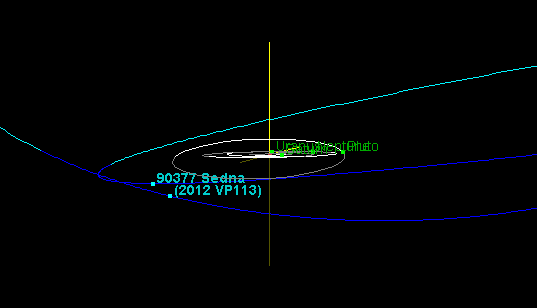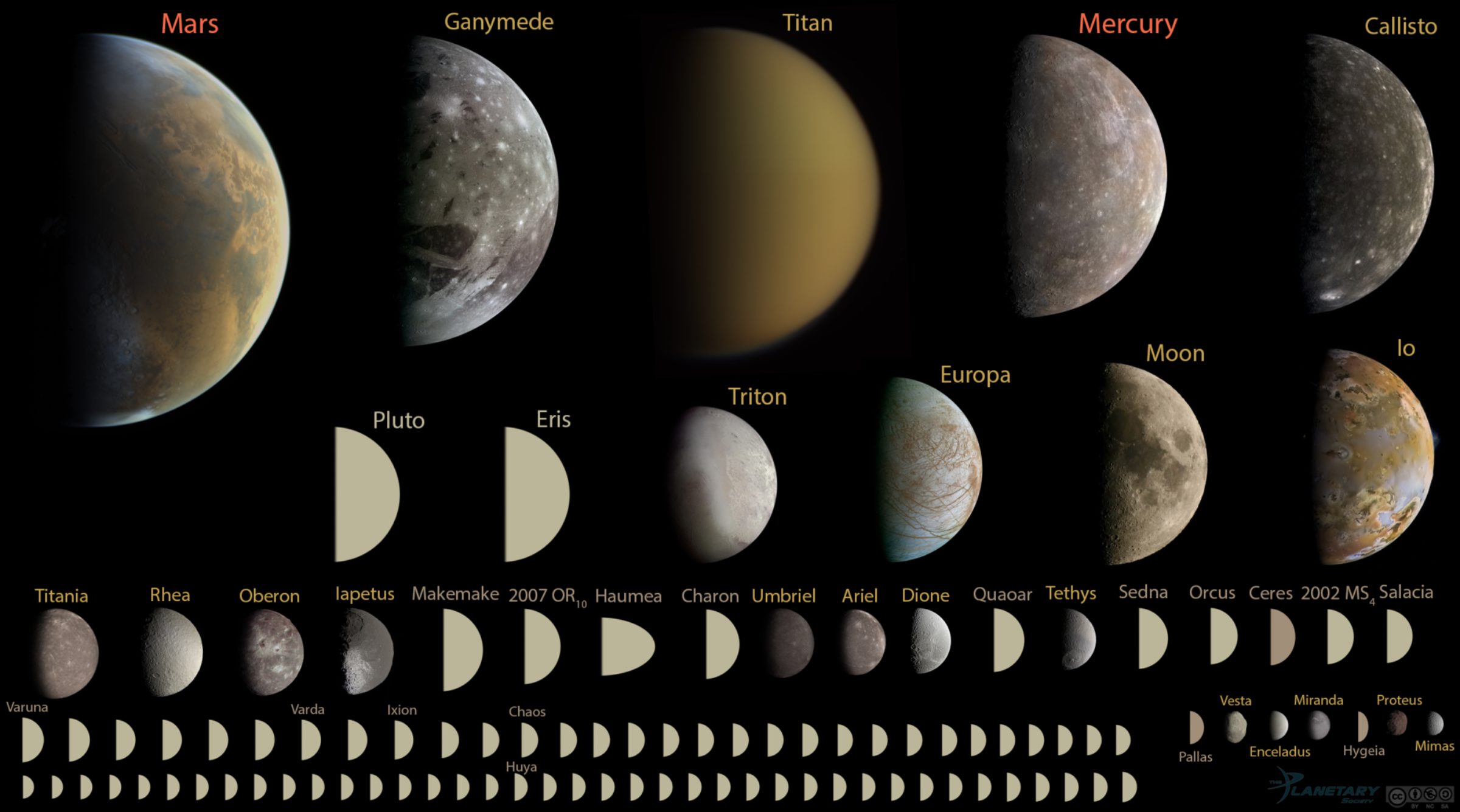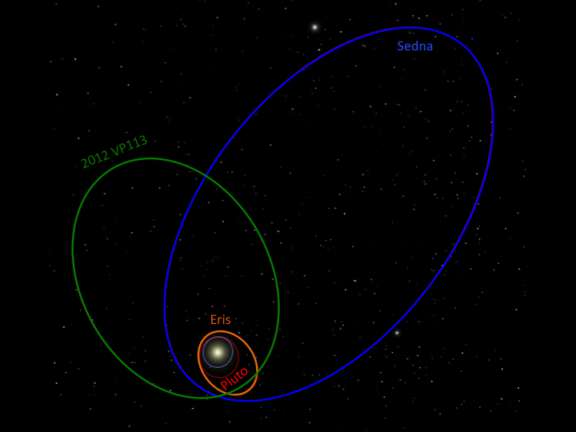Emily Lakdawalla • Mar 26, 2014
A second Sedna! What does it mean?
Chad Trujillo and Scott Sheppard have discovered an incredibly distant body in an unusual location in the solar system. The discovery was reported today in a Minor Planet Electronic Circular and also a Nature paper. The discovery of a new trans-Neptunian object is cool, but no longer rare; what makes 2012 VP113 special is its position. It never approaches closer to the Sun than 80 AU (that is, 80 times Earth's distance, or nearly 3 times Neptune's distance), and is usually much farther away, as far as 450 AU. There is only one other world in the solar system that has an orbit anything like 2012 VP113's: Sedna.
Astronomers have been searching for a second Sedna for a long time (really, ever since Mike Brown discovered Sedna), so it's more of a relief than anything else that Trujillo and Sheppard finally discovered one. There is a lot of speculation on the Internet today that it implies the existence of an as-yet-undiscovered planet at a similar distance from the Sun. But I've now learned that, as cool as the discovery is, it doesn't yet tell us a whole lot more than Sedna's existence did. The discovery does tell us that it's worthwhile to keep looking for more such worlds.
So, to explain why 2012 VP113 is interesting, I have to back up and explain why Sedna is interesting. Because I wanted to make sure to get this part right, I called Hal Levison, who does a lot of work using what we know about the orbits of the solar system's worlds to understand how the solar system formed in the first place. He helped me out by explaining what dynamicists currently think that the existence of Sedna means.
First, let's talk about the Oort cloud, the spherical shell of icy bodies that orbits extremely far away, in a vast region spanning space from thousands to tens of thousands of AU from the Sun -- a non-negligible fraction of the distance from the Sun to neighboring stars. This stuff didn't begin its existence so far from the Sun, Hal explained to me:
You start out with a bunch of icy guys between the planets. And they start to scatter outward. If you think about it, you do planet flybys to get velocity kicks. Spacecraft do it all the time. The planet can't put you on an orbit that doesn't cross its orbit anymore, because it's just a velocity kick, it's not a position kick. So in the early stages, when the planets are forming, they're scattering these cometary objects around in such a way that the perihelion still remains among the planets, but the semimajor axis is doing a random walk as you get scattered. So the semimajor axis is bopping around and slowly growing because it's diffusing outward, until the point where the galaxy can become important gravitationally. And that acts as a torque. What the galaxy does is it doesn't change the semimajor axis, but it does change the perihelia distance. So you get out to a few thousand AU and the galaxy can lift the perihelia away from the planetary system and then you're frozen in the Oort cloud.
Sedna -- and the newly discovered 2012 VP113 -- get very far from the Sun, but nowhere close to the inner edge of the Oort cloud. Ever since Sedna's discovery, theorists have been trying to explain how you can get a world at its intermediate distance from the Sun -- far from any planets, but also far from the Oort cloud. It's in a region of space that Trujillo and Sheppard refer to as the "inner Oort cloud," but Hal likes to call the "first-generation Oort cloud," for reasons I'll explain in a moment. Hal explained why Sedna is weird:
The interesting thing about Sedna is the galaxy doesn't become important until 5 or 6 thousand AU. Maybe 3, depending on what you're doing. But it's thousands of AU. Sedna is on an eccentric orbit, and it can't form on that orbit, it's got to be on a circular orbit in order to accrete. So it got scattered by something, but it's too far away from the planets for them to do it, because the perihelion is too large, and it's too close to the Sun for the galaxy to do it. So Sedna was a surprise because it's in a "no man's land" because we don't know of anything that could put it there.
Here is where a possible planet comes in. In a series of blog posts (Parts 1, 2, and 3) relating his discovery of Sedna and what it means, Mike Brown outlined his three favorite explanations for how Sedna formed: either there is an undiscovered planet orbiting the Sun near Sedna's perihelion position; or a passing star had approached to within several hundred AU of the Sun and disturbed orbits of objects it passed near; or a model relating to the fact that Earth was born in a star cluster. Mike likes to discover new things so he said he liked the planet X a lot, but he thought the most likely explanation was the star cluster one. Here is how he describes the model:
Instead of getting one big kick from an improbably passing star, imagine that Sedna got a lot of really small kicks from many stars passing by not quite as closely. The chances of this happening might seem low, too, but astronomers have long known that most stars are born not alone, but in a litter of many stars packed together. How tightly? In our region of the galaxy, there is currently something like one star per cubic parsec (don’t worry too much about these units here; suffice it to say that a parsec is a little less than the distance to the nearest star, so it is not surprising that in a box with edges about that length there is about one star). In the cluster of stars in which the sun might have been born there would have been thousands or even tens to hundreds of thousands of stars in this same volume, all held together by the gravitational pull of the massive amounts of gas between the still-forming stars. I firmly believe that the view from the inside of one of these clusters must be one of the most awesome sights in the universe, but I suspect no life form has ever seen it, because it is so short-lived that there might not even be time to make solid planets, much less evolve life. For as the still-forming stars finally pull in enough of the gas to become massive enough to ignite their nuclear-fusion-powered cores they quickly blow the remaining gas holding everything together away and then drift off solitary into interstellar space. Today we have no way of ever finding our solar siblings again. And, while we see these processes occurring out in space as other stars are being born, we really have no way to see back 4.5 billion years ago and see this happening as the sun itself formed.
The process that would put Sedna and friends into Sedna-like orbits is actually no different from how the Oort cloud formed; it just operated earlier (as the solar system was forming, rather than later), and because of the close-packed environment it operated at a smaller distance scale (so the cloud of objects you'd create would be smaller than the Oort cloud). Which is why Hal likes the "first-generation Oort cloud" moniker for the region of space occupied by Sedna and now 2012 VP113; it's an Oort cloud that formed before what we usually think of when we talk about the Oort cloud. It's also why studying objects like Sedna is really cool. "The orbits of things in the inner Oort cloud can tell us about the conditions of the cluster in which the Sun formed," Hal told me. Mike explained more in his post:
If Sedna got put on its peculiar orbit by the interactions of all of these stars 4.5 billion years ago, it is now a fossil record of what happened at the time of the very birth of sun. Everything else in the solar system has been kicked and jostled and nudged by planets big and small so there is no way to trace them back 4.5 billion years. Sedna, on the other hand, has been doing nothing but going around and around the sun in its peculiar elongated orbit every 12,000 years. After almost half a million of those orbits, Sedna remains lonely and untouched by anything else. By watching the orbit of Sedna we could be watching 4.5 billion years in the past.
In order to learn about the conditions of the star cluster, though, we need more than just Sedna. And we even need more than just Sedna and 2012 VP113. We need a whole population of objects that have served as tracer particles for the forces that shaped the solar system. Which is why the discovery of 2012 VP113 is cool but not yet really able to tell us much more about the solar system than we already knew. It tends to confirm the star-cluster-birth model of solar system formation, which is good. Meg Schwamb elaborated on this in a "News and Views" piece published in Nature along with the research article: "This suggests that Sedna and 2012 VP113 are the tip of the iceberg for this population of distant inner Oort cloud objects. Most objects in the inner Oort cloud would reside at distances farther than Sedna and 2012 VP113. For only an extremely small fraction of their orbits around the Sun would these inner Oort objects be bright enough to be detected in current ground-based surveys."
It's really quite striking how close Sedna and 2012 VP113 are to each other right now, both close to their perihelia, both at around 80 AU. Here's an illustration that I put together using the JPL Small-Body Database Browser that shows you just how close they are.

Their current proximity is mostly a coincidence, given the fact that they have different orbital periods; there's nothing about their orbits that says they should be in the same place at the same time, except for the fact that their orbits happen to take them to similar spots in the sky when they are close to the Sun. But we are more likely to discover such objects when they are near perihelion (hence brighter and moving faster), so given the proximity of their perihelia they would've been somewhat close to each other in the sky because that's where we could see them both.
The fact that they have perihelia at similar locations is an interesting observation, though. And it's one that Trujillo and Sheppard noticed, too. The position of a world at perihelion is described by an angle called the argument of perihelion or ω. Trujillo and Sheppard wrote:
Both Sedna and 2012 VP113 have similar arguments of perihelion (311° and 293°, respectively). The orbital element ω describes the angle between the point of perihelion and where a body’s orbit crosses the celestial plane. Surprisingly, this ω similarity is shared for all known objects with semi-major axes greater than 150 AU and perihelia greater than that of Neptune.... We find that this ω clustering cannot be due to observational bias...
They went on to hypothesize that the clustering of argument of perihelia resulted from "a massive outer Solar System perturber" that "restricts ω for the inner Oort cloud objects." They showed that it works for a super-Earth at 250 AU, but "This configuration is not unique and there are many possibilities for such an unseen perturber."
A brief digression: recently, the WISE mission issued a press release stating that their survey of distant, cold objects had turned up no "Planet X." However, if you take time to read beyond the headline, you'll find that they mostly eliminated the possibility of an undiscovered planet the size of Saturn or larger, but there is still plenty of room for an object the size of Neptune, Earth, or Mars. It's no problem to hypothesize the super-Earth that Trujillo and Sheppard propose.
I have confess to a bias here: I really wanted this coincidence in argument of perihelion to be strong evidence of a planet X. I would love for there to be a planet X. So would Trujillo and Sheppard, evidently, because they spent quite a bit of space showing it could work. And so would Nature, because then the first clear indication of a planet X would be in an article published in their journal.
But Hal dashed my hopes, or at least my certainty. "It's a very weak result," he told me; and indeed the paper spends more column inches on what 2012 VP113 tells us about the inner Oort cloud as a population than it does about this potential "perturber." Meg Schwamb seems to agree; her News & Views piece didn't even mention the possibility of a planet, only that "This result may be the first hint we have of an identifiable signature of the inner Oort cloud’s formation mechanism on the orbits of closer-in Solar System bodies. If true, any formation mechanism proposed for the origin of Sedna and 2012 VP113 will need to explain this orbital structure."
Hal told me that he looked carefully at whether the clustering in argument of perihelion could just be a statistical fluke, but that ultimately, he "believes the data."
The question is whether it's a planet. And then you have to be a little careful. If this population were massive enough, if there were like one or two Earth masses in it, which is possible, because something like a hundred Earth masses was scattered out as Uranus, Neptune, Jupiter, and Saturn were growing, then maybe it's the self-gravity between these objects themselves that's doing it. There may be other explanations for this, rather than the extreme position of, "it's a planet"; but I can believe there's something going on.
Hal was more interested in a different coincidence about Sedna and 2012 VP113. "It's a little odd that the first two objects that have been discovered have perihelia that large. There's not a guy at 55 or 60 AU. It probably means there's an inner edge to this population; that certainly would constrain things." I poked at this, really wanting the distance to tell me that there was a planet X at 80 AU, but unfortunately, it doesn't work that way. Hal said that some solar system formation simulations do turn out to have an inner edge to the inner Oort cloud or first-generation Oort cloud without the help of any interloping planet, "Because you have to get far enough away from the planets to stabilize the orbits for long periods of time. I don't think it's hugely surprising that that edge is there." He pointed me to this 2012 paper, which mentions a 100-AU inner edge in the abstract.
So 2012 VP113 joins Sedna in what we can now assume will be a growing family of first-generation Oort cloud objects. What does this object look like -- does it belong on my list of the round worlds in the solar system? Unfortunately, we can't say yet. It's probably smaller than Sedna, because it's substantially dimmer; its absolute magnitude is 4.12, compared to Sedna's 1.5. The paper also says that it has a moderately red optical color, "consistent with formation in the gas giant region and not in the ultra-red dominated classical Kuiper belt." Depending on how intrinsically bright its surface is, it could be anywhere from 300 to 1000 kilometers in diameter; Trujillo and Sheppard bet on about 450 kilometers, which would put it among the bottom row of unseen worlds on this figure, roughly the size of Huya or Proteus. Maybe round, maybe not. Regardless, it's a new world, with its own story to tell!

Let’s Go Beyond The Horizon
Every success in space exploration is the result of the community of space enthusiasts, like you, who believe it is important. You can help usher in the next great era of space exploration with your gift today.
Donate Today

 Explore Worlds
Explore Worlds Find Life
Find Life Defend Earth
Defend Earth


